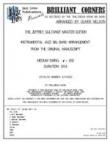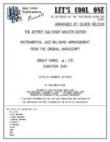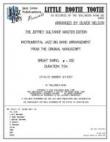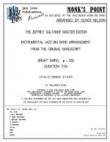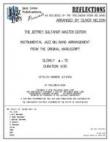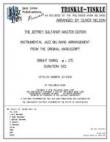Monk, Thelonious
There are few figures in American music history who are as important and truly singular in just about every way as Thelonious Monk. He entered the world on October 10, 1917, in Rocky Mount, NC. With a name as unusual and memorable as the piano style he would ultimately master, Thelonious Sphere Monk began playing piano as a child, and soon showed unmistakable signs of the highly advanced musical mind that would eventually develop a piano style unlike any that had been seen previously.
Having moved to New York City with his family as a child, Monk was exposed early on to music by his multi-instrumentalist father, he played piano in church, took part in amateur competitions, and took in the many different styles of music heard in one of the world's music capitals. He attended one of the city's best high schools, which was a magnet for gifted students, but dropped out before graduating to pursue a career in music. He toured with an evangelist and led his own band before becoming house pianist at Minton's, a legendary jazz club in Harlem. Jamming with fellow pioneers of the time such as Dizzy Gillespie, Charlie Parker, Kenny Clarke, and others, Monk was a central figure in the development on bebop. His still-developing style, with revolutionary ideas on rhythm and dissonance, as well as the use of space and silence, gave other musicians tremendous freedom to create; in his way Monk was an ideal figure to help usher in the central bebop tenet of revolutionary creativity in soloing.
From the mid-1940s through the mid-1950s, Monk played with a succession of greats, from Coleman Hawkins and Art Blakey to Miles Davis and Sonny Rollins, participating in many sessions that would ultimately become regarded as classics, especially his Blue Note Genius of Modern Music records. As can be the case with true artistic revolutionaries, his style was not quick to be appreciated or even understood by most. As he was also somewhat introverted and could demonstrate idiosyncratic behavior onstage and off, all of this combined with his stylishly unique manner of dress led him to be regarded as a somewhat aloof character. His records were not yet good sellers, and his music was somewhat difficult for a mainstream audience to accept. But he pressed on, and his fortunes would drastically improve in the latter part of the 1950s. Monk was soon recording more of his own compositions, and 1957's Brilliant Corners was his artistic breakthough. Filled with extremely complex music, the record contained two of the many songs of his that would become standards, the title track and Bemsha Swing, and firmly established Monk as a creative genius of the highest level. Later that year a very successful residency at the Five Spot Cafe in New York City with John Coltrane solidified his newfound popularity. By the early 1960s he had established a quartet including tenor saxophonist Charlie Rouse, beginning what would become a longtime collaboration. He signed with Columbia Records, which would give him more promotion, distribution, and sales success than he had seen previously, and his elevation in status was reflected by his gracing the cover of Time Magazine in 1964, a very rare honor for a jazz musician.
He toured throughout the decade, released many more successful albums, and continued to be a major figure on the jazz scene. His profile was certainly colored by some misperceptions about the man he really was; long perceived as distant and reclusive, not everyone was aware of the devoted family man he was, spending much time with his wife and children. By the latter part of the 1960s, the explosion of the popularity of rock music was responsible for seismic changes on the American music scene, and Monk struggled to remain at the forefront of the music world. In the early 1970s, he was dropped by Columbia, and spent time touring with the Giants of Jazz, a supergroup also featuring Gillespie and Blakey. Monk's behavior became more erratic and unpredicatble during this time, and, sadly, by the mid-1970s he was suffering from mental illness that has been widely debated and he ceased playing music entirely. He was prescribed various medications that may have continued to hasten his decline. He suffered a stroke in February 1972 and died at age 64 in Weehawken, NJ on February 17, 1982.
The years since his death have seen his profile cemented as of one of the true architects of the jazz canon. Instrumental in the development of bebop, author of dozens of jazz standards, progenitor of a piano style that is both instantly recognizable and dazzlingly original, Thelonious Monk is responsible for vastly widening the possibilities of the jazz genre with his ideas on music. This is perhaps best summarized by always insightful critic Scott Yanow's stating that Monk was among the most important jazz musicians who were "successful in creating their own original world of music with its own rules, logic, and surprises." Combined with his unique persona and style of dress, Monk cut a figure rarely seen in Western musical history. His songs are among the most recorded in the jazz genre, he is regarded along with Duke Ellington as among the handful of jazz's greatest and most important composers, and his ideas on rhythm and melody are endlessly studied and imitated.
The legacy of Thelonious Monk is kept very much alive and thriving by the outstanding efforts of his son, drummer T.S. Monk. He was instrumental in founding the Thelonious Monk Institute of Jazz, which is world-renowned for the scholarships they award and the educational programs they create and offer. Their Thelonious Monk International Jazz Competition is hugely popular and has helped launch the career of many jazz stars.
Thelonious Monk did what revolutionaries do-he saw things differently, he pushed the boundaries of the possible, and he left an indelible mark on the idea of what jazz could be. It took some time for the world to catch up with him, but when it finally did it never looked back. His career gave the jazz universe one of its greatest gifts, and the omnipresence of his sound in the jazz idiom to this day further solidifies the timeless brilliance of one of the greatest minds in American musical history.
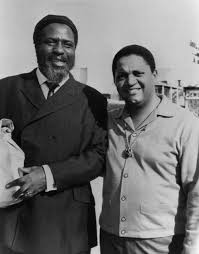
THELONIOUS MONK BIG BAND JAZZ LINES PUBLICATIONS SERIES: COMPLETE SET OF SIX ARRANGEMENTS
Recorded by the Thelonious Monk Big Band
Six Jazz Big Band Arrangements
Jazz Lines Publications
JLP-1003
$345.00
THELONIOUS MONK BIG BAND JAZZ LINES PUBLICATIONS SERIES: COMPLETE SET OF SIX ARRANGEMENTS [DOWNLOAD]
Recorded by the Thelonious Monk Big Band
Six Jazz Big Band Arrangements
Jazz Lines Publications
JLP-1003DL
$345.00
Recorded by the Thelonious Monk Big Band
Jazz Big Band Arrangement
Jazz Lines Publications
JLP-8363
$65.00
Recorded by the Thelonious Monk Big Band
Jazz Big Band Arrangement
Jazz Lines Publications
JLP-8363DL
$65.00
Recorded by the Thelonious Monk Big Band
Jazz Big Band Arrangement
Jazz Lines Publications
JLP-8364
$65.00
Recorded by the Thelonious Monk Big Band
Jazz Big Band Arrangement
Jazz Lines Publications
JLP-8364DL
$65.00
Recorded by the Thelonious Monk Big Band
Jazz Big Band Arrangement
Jazz Lines Publications
JLP-8367
$65.00
LITTLE ROOTIE TOOTIE [DOWNLOAD]
Recorded by the Thelonious Monk Big Band
Jazz Big Band Arrangement
Jazz Lines Publications
JLP-8367DL
$65.00
Recorded by the Thelonious Monk Big Band
Jazz Big Band Arrangement
Jazz Lines Publications
JLP-8365
$65.00
Recorded by the Thelonious Monk Big Band
Jazz Big Band Arrangement
Jazz Lines Publications
JLP-8365DL
$65.00
Recorded by the Thelonious Monk Big Band
Jazz Big Band Arrangement
Jazz Lines Publications
JLP-8366
$65.00
Recorded by the Thelonious Monk Big Band
Jazz Big Band Arrangement
Jazz Lines Publications
JLP-8366DL
$65.00



